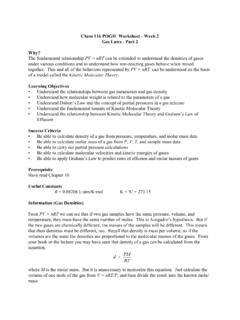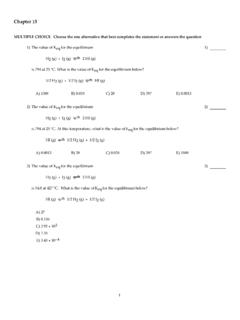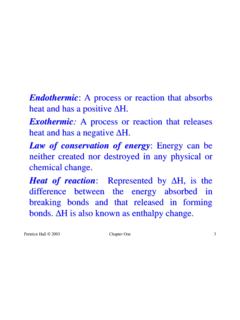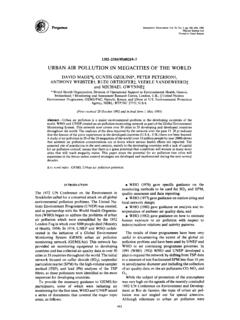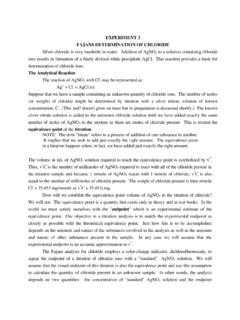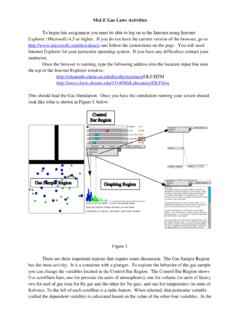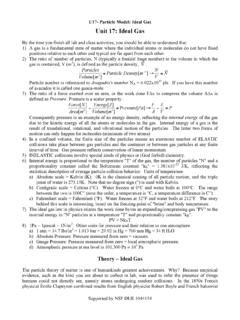Transcription of Chem 116 POGIL Worksheet - Week 1 Gas Laws - Part 1
1 Chem 116 POGIL Worksheet - week 1 Gas laws - Part 1 Why?Of the three principal states of matter (gas, liquid, solid), gases show behavior that is most easilyconnected to molecular motion. The observed behavior of gases, embodied in the empirical gaslaws, leads to a series of equations that can be summarized by a single equation of state, calledthe ideal gas law equation. This shows the relationship between a gas s pressure (P),temperature (T), volume (V), and amount in moles (n). Connecting these variables together is afundamental constant of the universe, called the gas constant (R).
2 Learning Objectives Understand the nature of the parameters that define the behavior of gases Know the names and relationships represented by the various empirical gas laws Understand the meaning of the ideal gas law Know how to extract the relevant relationship from the ideal gas law to predict the values ofgas parameters when sample conditions are changed Know standard temperature and pressure (STP)Success Criteria Be able to calculate pressure from fundamental equations of physics Be able to determine pressure from barometer and manometer readings Be able to carry out various empirical gas law calculations Be able to apply the ideal gas law Be able to use STP in gas-law calculations, when appropriatePrerequisiteHave read Chapter 10 Information (Defining Pressure)A sample of gas is characterized by specifying its amount, its temperature, its volume, and itspressure.
3 Most of us have a clear idea about the first three parameters, but our understanding ofpressure may be less precise. In physics, pressure is defined as force applied per unit of area, P = F/AForce is defined as the product of mass times acceleration, F = ma. Key SI units of kilograms, meters, and seconds with these fundamental equations,determine the combination of units that define the newton (N), the fundamental unit of pascal (Pa), the fundamental unit of pressureInformation (Measuring Air Pressure)Historically, air pressure has been measured by observing the height of the column in a (l)
4 Torricelli vacuumPHgPatmWhen the downward pressure of the mercury in the closed column exactly equals the air pressureon the surface of the mercury pool into which the open end of the tube is submerged, a stablelevel is achieved whose height can be used as an indication of the air pressure. In these terms wedefine one standard atmosphere (1 atm) as the pressure required to sustain a 760-mm height ofmercury, written 760 mm Hg. The unit of mm Hg is also called the torr, so 1 atm = 760 pressure of a column of liquid is given by P = gdh, where g is the acceleration ofgravity ( m@s 2), d is the density, and h is the height.
5 The density of mercury is What is the pressure in Pa exerted by a 760-mm column of mercury? the United States we quote barometric pressure in inches of mercury (in. Hg). What isone standard atmosphere of pressure in these units? (1 in. / cm) Europe barometric pressure is quoted in hectopascals (hPa), where hecto means onehundred. What is one standard atmosphere in hPa? typical 10W-40 motor oil has a density of g/cm3. If you were to construct abarometer using 10W-40 motor oil, how high would the column be when the pressure is oneatmosphere?
6 Information (Measuring Sample Gas Pressure - Manometers)Sample gas pressures are measured using the height difference in the U-tube of a manometer. Manometers are either closed-end or open-end in ManometerPgas = gdhgasclosed tubehOpen-Ended ManometerPgas = Patm + gdhgasopen tubeA closed-end manometer (above, left) gives an absolute measure of the pressure in torr; the open-end manometer (above, right) gives the pressure relative to the atmospheric pressure on the openend. To use an open-ended manometer, one must also know the barometric pressure at the timeof the to the pictures of closed- and open-ended manometers the manometer on the left, the left side reads 108 mm and the right side reads 32 is the pressure of the sample gas in torr?
7 The manometer on the right, the left (outer) side reads mm, and the right (inner)side reads mm. The pressure in the laboratory is mm Hg. What is thepressure of the sample gas in torr?iii. In the manometer on the right, if the heights of the two sides were reversed ( mm onthe left and mm on the right), what would the pressure of the sample gas be in torr?Information (Empirical Gas laws - Boyle s Law)Boyle s Law says that for a sample of gas at constant temperature the volume is inverselyproportional to the out the following steps to derive equations for Boyle s Boyle s Law as a proportion between V and proportionality can be changed into an equation by adding a proportionality constant.
8 For example, if y % x, we can use a constant, c, to write the equation y = cx. Do this forthe Boyle s Law proportionality you just wrote, making b be the Under what conditions is b a constant?iv. Consider a gas sample at constant temperature with an initial volume V1 and an initialpressure P1. Write an equation that shows how V1 and P1 are related to new volume andpressure conditions, V2 and P2, if either is changed. [Hint: look at the equation you wrotein part ii.] 144-mL sample of gas in a piston chamber has a pressure of atm.
9 If the piston ispushed in so that the gas has a volume of mL, what is the new pressure? Assume thetemperature remains (Empirical Gas laws - Charles Law)Charles Law says at constant pressure the volume occupied by a given amount of gas is directlyproportional to its absolute out the following steps to derive equations for Charles a proportionality between V and T that expresses Charles the proportionality constant c, write an equation for the relationship between Vand Under what conditions is c a constant?
10 Iv. What does absolute temperature mean? Why must we use absolute temperature in theequation for Charles Law? an equation for the relationship between initial temperature and volume, T1 andV1, and final temperature and volume, T2 and V2, when either of these is changed underconstant pressure A sample of gas in a piston chamber at 25 oC is heated to 100 oC, while the pressure ismaintained at atm. What is the volume of the gas after heating?Information (Empirical Gas laws - Combined Gas Law)Boyle s Law and Charles Law can be combined into one equation that expresses the volume,temperature, and pressure relationships for a fixed amount of Questions11.
